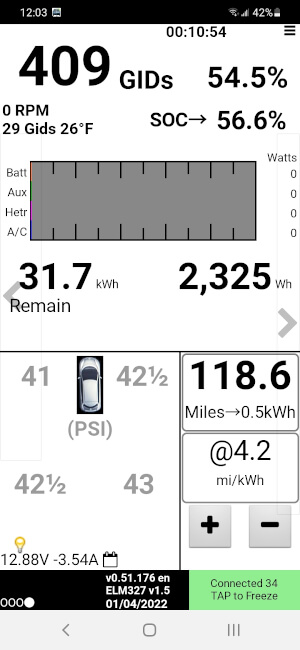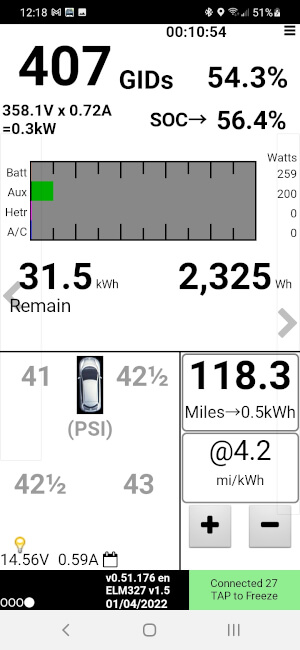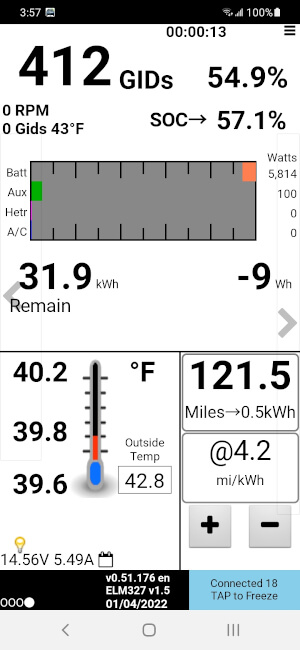knightmb
Well-known member
Yeah, not exactly about the Leaf traction battery, but I thought this could still fit into the "battery & charging" category since it's about a battery that is vital to the Leaf operation. 
Hoping this topic can be used as a way to share our experiences with changing out the OEM 12V battery in your Leaf with anything other than what the dealership wants to give you.
To start, I replaced my OEM 12V battery in my 2013 Leaf back in 2015. Since then, I've moved it from my old 2013 before trade-in to my newer 2020 Leaf where it continues to function today.
Where I live, the climate is warmer and so far, the temperature never gets below 0F (-17C) and even if it is in the single digits, that might only last a day or two. I do get a lot of events where the weekly temperature is below 32F (0C) for long periods of time, but nowhere near what someone living in Canada, Alaska, northern US get during the winter as my temperatures to them would be a warm spring day. :lol:
Having stated that, I do feel like the Lithium 12V battery gets a bad reputation as being failure prone when temperatures get below freezing. Not so much about the members of this forum, but basically everywhere you google about these batteries, you read about how if you try to charge them below 32F (0C) they can catch fire or damage the battery. I am aware of the technical limitations of the Lithium 12V (LiFePO4) when it comes to temperature extremes. When the temperature of the battery is below freezing, the amount of current it can absorb for charging is greatly reduced. Once the battery drops to -40F/C it will freeze to the point of taking internal damage.
I would never recommend someone who lives in any climate that will dip below -40F/C for any amount of time to use a LFP battery just for that reason, but some areas that experience cold temperatures that never get below 0F (-17C) or even some extremes of -20F (-28C) could still function in the Leaf well enough to get it started and with the somewhat, bizarre charging algorithm of the Leaf, would not suffer any charge problems due to the much higher initial voltage of the LFP.
In another topic, I made the claim that my own small, 20AH LFP should be able to turn on a Leaf hundreds of times before being depleted. The reason being, if the battery was too cold to charge, it should still retain enough capacity to start your Leaf over and over until the climate warms back up and it is able to absorb enough energy to reach full charge levels again. It does sounds like a skeptical claim and I'll be to first to admit I'm wrong if it's really not possible, so I'm just using a thought experiment to make sense of what I said.
Let's say my LFP is in good shape and can actually do the full 20AH of capacity. In theory, the battery nomial voltage is 12.8 V and with 20AH, that means it should be able to output at least 12.8v x 20a = 256 watts of power.
In my other Leaf experiments here: https://mynissanleaf.com/viewtopic.php?f=9&t=32820 I was measuring how much power it takes just to turn on the Leaf. My measurements record that every time I want to turn on my Leaf, it takes about 175 watts of power for 2 seconds to turn it on. In essence, it takes around (175 * (2/3600)) = 0.0972 watt/hours to start the Leaf. The battery is rated for 256 watt/hours, so every time you start the Leaf, you are depleting about 0.0972 / 256 = 0.00038 or 0.038% of the battery capacity with every push. So, in a perfect world, that would give you about 100 / 0.038 = 2,631 times to turn the Leaf on.
If I could never charge my LFP for a week for example because the temperature is always too low, there should be enough capacity to always make sure I can turn the Leaf on. Now this isn't accounting for the vampire drain of the computer in standby mode, which I measured to be around 0.158 watts of power. I haven't done a full day of measurements yet, but I'm sure every-time I access the Leaf with the app, that uses additional power, additional power is used when I sit down in the Leaf before turning it on, etc. All of those vampire drains will eat into that ideal starting total so it will certainly reduce it by some bit, but it seems that without the math, there should be enough left to cover starting the Leaf until the weather is warmer. Once I get a chance to measure a full day of "idle" power usage (I actually have a device that can do that on the 12V system), I'm going with my gut feeling that there should be enough capacity left over to keep one from being stranded in the Leaf even if the outside temperature is very cold for long periods of time.
Hoping this topic can be used as a way to share our experiences with changing out the OEM 12V battery in your Leaf with anything other than what the dealership wants to give you.
To start, I replaced my OEM 12V battery in my 2013 Leaf back in 2015. Since then, I've moved it from my old 2013 before trade-in to my newer 2020 Leaf where it continues to function today.
Where I live, the climate is warmer and so far, the temperature never gets below 0F (-17C) and even if it is in the single digits, that might only last a day or two. I do get a lot of events where the weekly temperature is below 32F (0C) for long periods of time, but nowhere near what someone living in Canada, Alaska, northern US get during the winter as my temperatures to them would be a warm spring day. :lol:
Having stated that, I do feel like the Lithium 12V battery gets a bad reputation as being failure prone when temperatures get below freezing. Not so much about the members of this forum, but basically everywhere you google about these batteries, you read about how if you try to charge them below 32F (0C) they can catch fire or damage the battery. I am aware of the technical limitations of the Lithium 12V (LiFePO4) when it comes to temperature extremes. When the temperature of the battery is below freezing, the amount of current it can absorb for charging is greatly reduced. Once the battery drops to -40F/C it will freeze to the point of taking internal damage.
I would never recommend someone who lives in any climate that will dip below -40F/C for any amount of time to use a LFP battery just for that reason, but some areas that experience cold temperatures that never get below 0F (-17C) or even some extremes of -20F (-28C) could still function in the Leaf well enough to get it started and with the somewhat, bizarre charging algorithm of the Leaf, would not suffer any charge problems due to the much higher initial voltage of the LFP.
In another topic, I made the claim that my own small, 20AH LFP should be able to turn on a Leaf hundreds of times before being depleted. The reason being, if the battery was too cold to charge, it should still retain enough capacity to start your Leaf over and over until the climate warms back up and it is able to absorb enough energy to reach full charge levels again. It does sounds like a skeptical claim and I'll be to first to admit I'm wrong if it's really not possible, so I'm just using a thought experiment to make sense of what I said.
Let's say my LFP is in good shape and can actually do the full 20AH of capacity. In theory, the battery nomial voltage is 12.8 V and with 20AH, that means it should be able to output at least 12.8v x 20a = 256 watts of power.
In my other Leaf experiments here: https://mynissanleaf.com/viewtopic.php?f=9&t=32820 I was measuring how much power it takes just to turn on the Leaf. My measurements record that every time I want to turn on my Leaf, it takes about 175 watts of power for 2 seconds to turn it on. In essence, it takes around (175 * (2/3600)) = 0.0972 watt/hours to start the Leaf. The battery is rated for 256 watt/hours, so every time you start the Leaf, you are depleting about 0.0972 / 256 = 0.00038 or 0.038% of the battery capacity with every push. So, in a perfect world, that would give you about 100 / 0.038 = 2,631 times to turn the Leaf on.
If I could never charge my LFP for a week for example because the temperature is always too low, there should be enough capacity to always make sure I can turn the Leaf on. Now this isn't accounting for the vampire drain of the computer in standby mode, which I measured to be around 0.158 watts of power. I haven't done a full day of measurements yet, but I'm sure every-time I access the Leaf with the app, that uses additional power, additional power is used when I sit down in the Leaf before turning it on, etc. All of those vampire drains will eat into that ideal starting total so it will certainly reduce it by some bit, but it seems that without the math, there should be enough left to cover starting the Leaf until the weather is warmer. Once I get a chance to measure a full day of "idle" power usage (I actually have a device that can do that on the 12V system), I'm going with my gut feeling that there should be enough capacity left over to keep one from being stranded in the Leaf even if the outside temperature is very cold for long periods of time.



